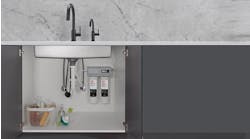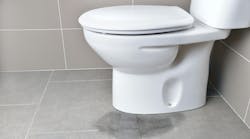Latest from Toilets
Sponsored
The cost to specify toilets throughout commercial and multi-family buildings can certainly add up.
But that fee pales in comparison to the hidden costs that come along with malfunctioning toilets. From clogs and poor performance that end up in maintenance costs and inflated utility bills to negative guest reviews and even property damage, these costs can really do damage to businesses.
This is especially true in these hospitality and multi-family housing industries, where guest and tenant satisfaction is paramount. While factors such as décor, site amenities, and customer service play a vital role, one often-overlooked aspect that can significantly impact the overall experience is restroom functionality, specifically, toilet performance.
But specifying high-efficiency, pressure-assisted toilets can make a substantial difference—from eliminating clogs to saving water. Let’s take a look.
Cutting Down on Clogs
Toilets with weak flushing power can lead to frequent clogs, resulting in repeated maintenance calls and increased operating costs. A study by the American Society of Plumbing Engineers (ASPE) found that commercial properties average 8–10 toilet-related maintenance calls per month for every 100 units. For hotels and multi-family residences, this not only adds to labor expenses and plumbing wear, but also negatively impacts guest and tenant satisfaction.
Clogged toilets are more than just a nuisance, they’re a drain on time, resources, and reputation. In high-traffic environments, the solution lies in performance. Pressure-assisted toilets significantly reduce the risk of clogs, freeing up maintenance teams for more pressing tasks and improving the overall user experience.
The Aloft Hotel in Portland, Maine is a great example. After outfitting nearly 160 rooms with pressure-assisted systems, the hotel saw a dramatic drop in clog-related service calls. Steven Fennell, Director of Engineering, noted that their “Code P” incidents—staff shorthand for toilet plunging requests—were “essentially eliminated” after installing pressure-assisted toilets.
Ensuring a Five-Star Review
Toilet failures can have a significant impact on guest experiences in hotels and tenant satisfaction in multi-family housing. In today’s world of online reviews, a single bad experience can prompt guests to share their frustrations on social media or review sites.
In fact, according to ReviewTrackers, 70% of guests are likely to discourage others after a poor service experience. For hotels, this can translate into lost bookings, as potential guests may be deterred by negative reviews.
In multi-family housing, unresolved bathroom issues can lead to tenant dissatisfaction, which may result in lease terminations or reluctance to renew. Tenants expect functional, reliable amenities, and consistent problems with toilets may create a perception of neglect, ultimately affecting the property’s reputation and profitability.
Saving Time and Money
Inefficient toilets not only cause maintenance headaches, but also waste significant amounts of water, leading to higher utility bills and environmental impact.
Traditional gravity-fed toilets can use up to 1.6 gallons per flush (gpf), but this can increase over time if common leak paths, such as the flapper, or fill valve, become worn or improperly sealed. These leaks, which often go unnoticed, can lead to the continuous flow of water into the bowl, wasting hundreds or even thousands of gallons annually. This hidden water waste adds up quickly, raising both utility costs and overall maintenance expenses.
In addition to financial costs, these leaks contribute to environmental strain, with unnecessary water consumption placing further stress on local water supplies. For example, a single leaky toilet can waste up to 200 gallons of water per day. Over the course of a year, this can lead to the loss of tens of thousands of gallons, further increasing the carbon footprint associated with water treatment and distribution processes.
In contrast, modern pressure-assisted toilets offer a more efficient solution. Offering models that flush at just 0.75, 1.0, or 1.28 gpf, these toilets maintain high-performance standards without compromising on power or reliability. The EPA’s WaterSense program reports that multi-family properties using WaterSense-certified toilets can save up to 13,000 gallons of water per unit annually leading to substantial reductions in both utility costs and environmental impact.
For hotels, where high guest turnover and frequent bathroom use are the norm, upgrading to water-efficient, pressure-assisted toilets can significantly enhance sustainability efforts while cutting down on maintenance calls. The reduced risk of leaks, lower water consumption, and decreased need for frequent repairs translate to long-term savings in operational costs, helping owners and property managers boost both their bottom line and environmental credentials.
Property Damage Problems
For homeowners, property managers, and multi-family property operators, toilet overflows and persistent leaks can lead to extensive and expensive damage. That’s because water from overflows can seep into flooring, walls, and ceilings causing mold growth, structural issues, and costly repairs.
Overflows are most often caused by clogs, which occur when waste isn't fully cleared from the bowl. Toilets with weak flush performance found in some gravity models or older fixtures are more prone to clogging, especially in high-traffic or multi-user environments.
In fact, the Institute for Business and Home Safety found that toilet failures are the leading cause of residential water damage claims, with an average cost of $5,500 per incident (not including deductibles).
Pressure-assisted flushing systems, such as those powered by Flushmate technology, provide a superior alternative to traditional gravity-fed toilets.
These systems use compressed air to deliver a powerful flush, reducing clogs, eliminating the need for double flushing, and minimizing water usage. The longevity of pressure-assisted units often surpasses that of standard toilets, providing a better long-term solution for property managers to reduce maintenance costs, save on water bills, and enhance guest and tenant satisfaction.
Mike Gembarski is Flushmate’s Senior Product Line Manager. For over 35 years, Flushmate has set out to build an environmentally conscious company by producing systems that deliver superior performance while conserving more water. Today, Flushmate is the preferred choice of installers and users around the world for pressure-assisted systems.


